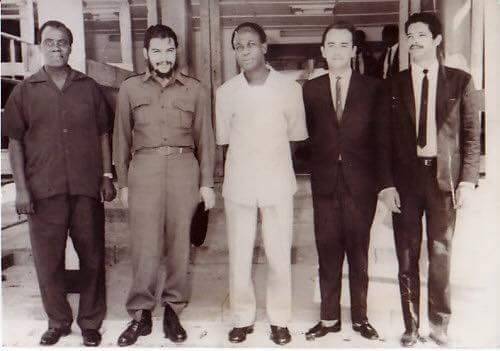afrikan-mapambano: One of the favorite libelous smears by right-wing hacks is that Marxist revolutio
afrikan-mapambano: One of the favorite libelous smears by right-wing hacks is that Marxist revolutionary Ernesto ‘Che’ Guevara was RACIST against black Africans. Being shameless, they usually attack where they think left-wing icons or heroes are strongest. From then on and throughout his life, Che showed he was ANTI-RACIST through his ACTIONS: 1- The following year in 1953, while travelling through Bolivia with his friend Carlos “Calica” Ferrer, Guevara became indignant when he observed that all the dark-skinned indigenous Indians had to be sprayed with DDT (ostensibly to kill lice) before being allowed to enter the Ministry of Peasant Affairs. 2- Che’s very first student in 1957 as a guerrilla fighter was a 45-year-old illiterate black guajiro named Julio Zenon Acosta, whom he was teaching the alphabet. After Acosta was killed in an ambush by Batista’s forces, Che exalted him as “my first pupil” and the kind of “noble peasant” that made up the heart of the Cuban Revolution. 3- During the Cuban guerrilla campaign, Che’s girlfriend (for all intents and purposes) for the first half of 1958 was Zoila Rodríguez García, a black/mulatto woman. Moreover, his first wife Hilda Gadea whom he married in 1955 was a dark-skinned indigenous Peruvian. 4- In 1959, Che pushed for racially integrating the schools and universities in Cuba, years before they were racially integrated in the southern United States. For context, the Alabama National Guard was needed to force Governor George Wallace aside at the University of Alabama in 1963 and forced school busing wasn’t enacted in the U.S. until 1971. 5- In 1959, Fidel & Che pushed through “Law 270”, which declared all beaches and other public facilities open to all races. For the first time in Cuban history, clubs, businesses, and other establishments that refused equal access and service to blacks were shut down. 6- In August 1961, (9 years after his “indolent” remark), Guevara attacked the U.S. for discrimination against blacks and the actions of the KKK, which matched his declarations in 1964 before the United Nations (12 years after his “indolent” remark), where Guevara denounced the U.S. policy towards their black population. It was around this same time, that the black anti-colonial philosopher Frantz Fanon proclaimed Che to be “the world symbol of the possibilities of one man.” 7- Che’s friend and personal bodyguard from 1959 till his death in 1967 was Harry “Pombo” Villegas, who was Afro-Cuban (black). Pombo accompanied Che everywhere in Cuba, then to the Congo and to Bolivia, where he survived and escaped the final battle where Che was wounded and captured. He resides in Cuba and wrote his own diary about his time in Bolivia entitled ‘Pombo: A Man of Che’s Guerrilla, With Che Guevara in Bolivia 1966-68’ and speaks positively of Guevara to this day. 8- In 1964, when Che addressed the U.N., he spoke out in favor of black musician Paul Robeson, in support of slain Congolese independence leader Patrice Lumumba (who he heralded as one of his heroes), against white segregation in the Southern U.S. (which still unfortunately existed), and against the white South African apartheid regime (long before it became the Western ’cause de jour’). Nelson Mandela later remarked that while he was imprisoned Che’s “revolutionary exploits, including on our own continent, were too powerful for any prison censors to hide from us.” 9- Che was heralded by Malcolm X during this trip to NYC and in contact with his associates to whom he sent a letter. On behalf of his actions in Africa, Che would also later be praised by the Black Panther’s Stokely Carmichael. The Black Panther’s even adopted their black berets in honor of Guevara iconic headwear. 10- In 1965, Che toured and met anti-colonial leaders from the African nations of Ghana, Tanzania, Congo Brazzaville and Benin. This led to Che assisting and befriending Angolan independence leader Agostinho Neto of the MPLA, Ghanaian leader Kwame Nkrumah, and Tanzanian President Julius Nyerere. Che also established Cuban collaboration through supplies and military support for Amilcar Cabral’s PAIGC in Guinea Bissau, Alphonse Massamba-Débat in Congo Brazzaville, and Laurent-Désiré Kabila in Congo Leopoldville. Later Guevara offered assistance to fight alongside the (black) FRELIMO in Mozambique, for their independence from the white Portuguese. 11- When Guevara ventured to the African Congo in 1965, he fought with a Cuban force of 130 Afro-Cubans (blacks) alongside all-black Congolese fighters, they then battled against a force comprised partly of white South African mercenaries and white Cuban exiles backed by the CIA. This resembled the fight in Cuba, where Che’s units were made up of many poor rural mulattos and blacks, against a Cuban army staffed at the top by whites with connections to the upper class. Of note, nearly all Cuban exiles who fled Che’s economic reforms to Miami throughout the early 1960’s were white, despite the island being 1/3 mulatto & black. 12- Che’s Congolese teenage Swahili interpreter for his African expedition named Freddy Ilanga lived until 2006 in Cuba, and his dying wish was to erect a lighthouse memorial to Guevara in Africa. In 2005 he told the BBC that Che “showed the same respect to black people as he did to another races.” -- source link




